Landmarks along the Central Axis
-
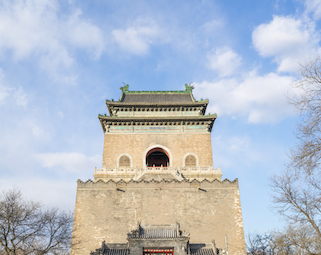
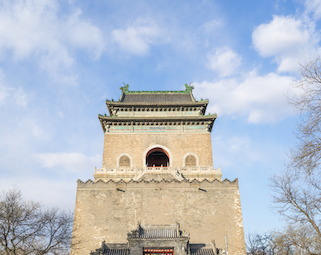 Bell Tower
Bell TowerThe Drum and Bell Towers, located at the northernmost point of the Central Axis, are both listed as "Major Historical and Cultural Sites Protected at the National Level". The towers stand in the old city's residential and commercial center, with the Drum Tower to the south of the Bell Tower. Historically, the Drum Tower was used for timekeeping and the Bell Tower for telling time. Today's Bell Tower was a reconstruction in the Qing Dynasty, while its enormous bell was cast in the Yongle period of the Ming Dynasty. Situated in the south of the Bell Tower, the Drum Tower was built in the Ming Dynasty and now is known for its exhibition of large drums and regular performance.
The Drum and Bell Towers are historical sightseeing spots and great places for the public to overlook the city.
Address: No. 9 (temporary number), Zhonglouwan Hutong, Dongcheng District, Beijing Municipality
Opening hours: 9:30–17:30, peak season (April 26–October 25). The ticket packages and single tickets for the Drum and Bell Towers can be purchased before 16:30 and 17:00, respectively, on the day; tickets can be purchased online before 15:30 on the day; last entry at 17:20).Off-season (October 26–April 25), 9:30–16:30 (The ticket packages and single tickets for the Drum and Bell Towers can be purchased before 15:30 and 16:00, respectively, on the day; tickets can be purchased online before 16:30 on the day; last entry at 16:20).
During the Spring Festival, the May Day holiday, and the National Day holiday, the time for ticket sales, entry, and closing of the Drum and Bell Towers will be half an hour later than normal.
Tickets: Drum Tower, full ticket CNY 20, half ticket CNY 10. Bell Tower, full ticket CNY 15, half ticket CNY 7. Ticket package CNY 30, half ticket CNY 15.Official tel: (8610)84027869, (8610)84036706
(Source: Cloud Central Axis Mini Program, Beijing Drum and Bell Towers WeChat Official Account)
-
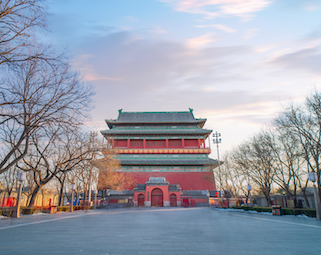
 Drum Tower
Drum TowerThe Drum and Bell Towers, located at the northernmost point of the Central Axis, are both listed as "Major Historical and Cultural Sites Protected at the National Level". The towers stand in the old city's residential and commercial center, with the Drum Tower to the south of the Bell Tower. Historically, the Drum Tower was used for timekeeping and the Bell Tower for telling time. Today's Bell Tower was a reconstruction in the Qing Dynasty, while its enormous bell was cast in the Yongle period of the Ming Dynasty. Situated in the south of the Bell Tower, the Drum Tower was built in the Ming Dynasty and now is known for its exhibition of large drums and regular performance.
The Drum and Bell Towers are historical sightseeing spots and great places for the public to overlook the city.
Address: No. 9 (temporary number), Zhonglouwan Hutong, Dongcheng District, Beijing Municipality
Opening hours: 9:30–17:30, peak season (April 26–October 25). The ticket packages and single tickets for the Drum and Bell Towers can be purchased before 16:30 and 17:00, respectively, on the day; tickets can be purchased online before 15:30 on the day; last entry at 17:20).Off-season (October 26–April 25), 9:30–16:30 (The ticket packages and single tickets for the Drum and Bell Towers can be purchased before 15:30 and 16:00, respectively, on the day; tickets can be purchased online before 16:30 on the day; last entry at 16:20).
During the Spring Festival, the May Day holiday, and the National Day holiday, the time for ticket sales, entry, and closing of the Drum and Bell Towers will be half an hour later than normal.
Tickets: Drum Tower, full ticket CNY 20, half ticket CNY 10. Bell Tower, full ticket CNY 15, half ticket CNY 7. Ticket package CNY 30, half ticket CNY 15.Official tel: (8610)84027869, (8610)84036706
(Source: Cloud Central Axis Mini Program, Beijing Drum and Bell Towers WeChat Official Account)
-
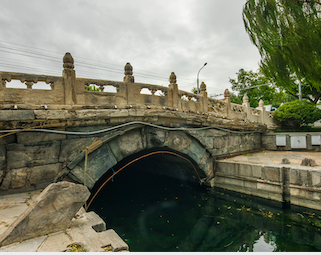
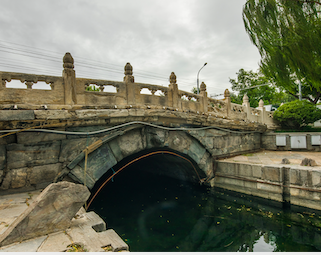 Wanning Bridge
Wanning BridgeSituated at the east shore of the Shichahai, Wanning Bridge is the oldest overpass on the Central Axis of Beijing and a national key protected cultural relic. It has been known by other names, including Haizi Bridge, Bei'an Bridge, Di'an Bridge, and Houmen Bridge, but is today known as Wanning Bridge, which was also its original name. Wanning Bridge has stood the test of time and witnessed the changes and development of the layout of the Central Axis since the Yuan Dynasty.
Address: Di'anmenwai Dajie, Xicheng District, Beijing Municipality
Opening hours: All day throughout the year
Tickets: Free
(Source: Cloud Central Axis Mini Program)
-
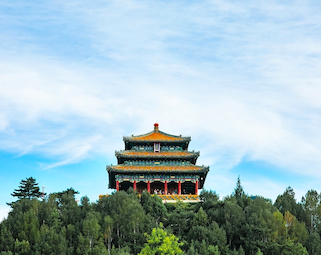
 Jingshan Hill
Jingshan HillJingshan Park, which is a national key protected cultural relic, was an imperial park in the Ming and Qing dynasties (1368-1911). The park constitutes the commanding height on Beijing's Central Axis with its location selected according to the principles of feng shui. The construction of the Forbidden City started during the reign of Emperor Yongle in the Ming Dynasty, when a city moat was dug, and mounds of soil were moved to the ruins of the old palace of the Yuan Dynasty. That was how Jingshan Hill, or Wansuishan as it was previously known,,was formed. The palaces and gardens in the park served as sites for worshiping nature and the ancestors, and have thus become unique examples of the national sacrifice rituals and traditions in the Ming and Qing dynasties.
Address: No. 44 Jingshanxi Street, Xicheng District, Beijing
Opening hours: 6:00–21:00 (last entry at 20:30) from April 1 to October 31;6:30–20:00 (last entry at 19:30) from November 1 to March 31
Tickets: CNY 2/person (adults), CNY 1/person (students with valid student ID card)
Official tel.: (8610)64038098
(Source: Cloud Central Axis Mini Program)
-
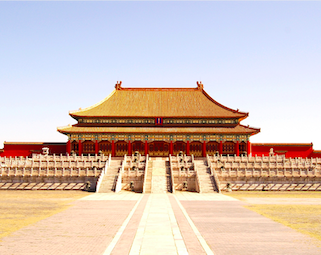
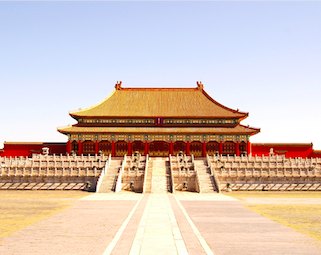 The Forbidden City
The Forbidden CityThe Palace Museum, also known as the Forbidden City, was the imperial palace complex of the Ming and Qing dynasties. It stretches 961 meters from north to south and 753 meters from east to west. The whole complex is surrounded by crimson walls with a 52-meter-wide city moat dug around the wall.
The Forbidden City was set up as a national museum in 1925 and it is the biggest museum of ancient culture and art in China. It not only served as the residence of the royal family and the place for the emperor to handle state affairs, but also the carrier of traditional ceremonials and the outstanding epitome of ancient Chinese palatial architecture.
Address: No. 4 Jingshanqian Street, Dongcheng District, Beijing Municipality
Opening hours: 8:30–17:00 (last entry at 16:10) during peak season (April 1–October 31), with tickets purchased before 16:00 on the day; 8:30–16:30 (last entry at 15:40) during off-season (November 1–March 31) with tickets purchased before 15:30 on the day.
Tickets: Peak season (April 1–October 31), CNY 60/person;
Off-season (November 1–March 31), CNY 40/person;
Ticket to the Treasure Gallery (The Palace of Tranquil Longevity Sector, including the Opera Gallery and Stone Drum Gallery): CNY 10/person.
Ticket to the Hall of Clocks (The Hall for Ancestral Worship sector): CNY 10/person
Official tel: (8610)85007057; (8610)85007058; (8610)85007062; (8610)85007063
(Source: Cloud Central Axis Mini Program)
-
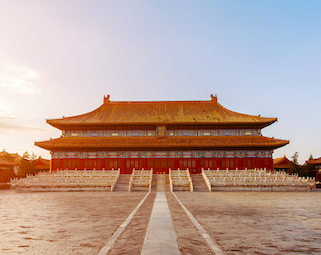
 The Imperial Ancestral Temple
The Imperial Ancestral TempleThe Imperial Ancestral Temple was where the emperors of the Ming and Qing dynasties worshiped their ancestors, serving as an important national temple to display traditional etiquette. It is also the best-preserved and largest existing imperial temple for the worship of ancestors in China and a national key protected cultural relic. The Imperial Ancestral Temple and the Altar of Earth and Harvests on the west of Tian'anmen are symmetrically situated at the east and west of the Forbidden City. The Imperial Ancestral Temple is now open to the public and managed and used by the Beijing Working People's Cultural Palace.
Address: East side of Tian'anmen, Dongchang'an Avenue, Dongcheng District, Beijing Municipality
Opening hours: 6:30-19:30 during spring and summer; 7:00-17:30 during autumn and winter
Tickets: CNY 2/person (free entrance for senior citizen)
Tel: (8610)65252189
(Source: Cloud Central Axis Mini Program)
-
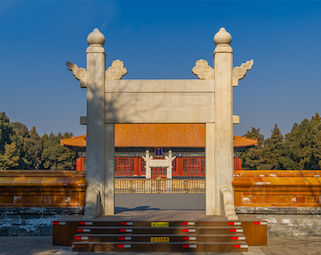
 Imperial Divine Temple
Imperial Divine TempleThe Imperial Divine Temple was the ritual site for the emperors of the Ming and Qing dynasties where they would perform ceremonies of soil and grain to affirm their sovereignty. It is a national key protected cultural relic. It is located at the southwest corner of the Palace Museum, close to and symmetrically aligned with the Imperial Ancestral Temple.
In 1914, the Imperial Divine Temple was turned into a park, making it the first imperial sacrificial building on the Central Axis of Beijing to open to the public. In 1928, to commemorate Dr. Sun Yat-sen (Sun Zhongshan), it was renamed Zhongshan Park, which is still open to the public today.
Address: West of Tian'anmen, Xichang'an Avenue, Dongcheng District, Beijing Municipality
Opening hours: 6:00–22:00 (last entry 21:00), June–August; 6:00–21:00 (last entry 20:00), April–May and September–October; 6:30–20:00 (last entry 19:00), November–March
Tickets: Full ticket CNY 3, half ticket CNY 1.5
Official tel.: (8610)66055431 (hotline of the Zhongshan Park)
(Source: Cloud Central Axis Mini Program)
-
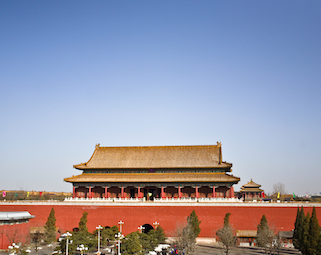
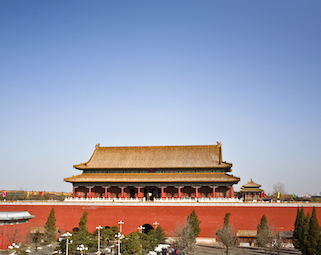 Duanmen
DuanmenLocated between Tian'anmen and Wumen, Duanmen used to be a storage place for ceremonial purposes during the Ming and Qing dynasties. It once played an important role in forming the spatial order for the ancient political center and is now used to house the Duanmen Digital Museum of the Palace Museum.
Address: Inside of the Palace Museum, No. 4 Jingshanqian Street, Dongcheng District, Beijing Municipality
Opening hours: 8:30-17:00 (last entry 16:10) during peak season (April 1–October 31) 8:30-16:30 (last entry 15:40) during off-season (November 1–March 31)
Tickets: CNY 60/person during peak season, CNY 40/person during off-season. The ticket applies to halls and galleries in the Palace Museum
Official tel.: (8610)85007057
(Source: Cloud Central Axis Mini Program)
-
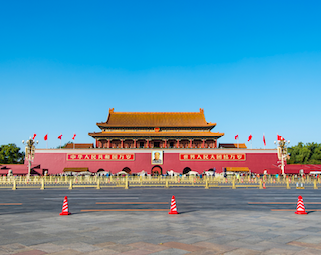
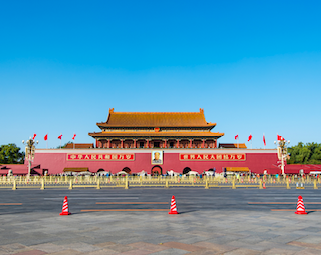 Tian'anmen Square
Tian'anmen SquareTian'anmen Square, once serving as the imperial square right outside the main entrance of the Forbidden City, has gradually been constructed into an open and modern square since 1912. It is the largest city center square in the world and a new focal point of Beijing's Central Axis. The Tian'anmen Square building complex consists of the Tian'anmen Square, the Monument to the People's Heroes, the Chairman Mao Memorial Hall, the Great Hall of the People, and the National Museum of China.
As one of China's most important architectural achievements of the second half of the 20th century, the complex has adopted the design principle of the Central Axis, ensuring all buildings are aligned and symmetrical. It is not only the development and extension of the Central Axis but also a sign of respect for its layout and order.
Address: Dongchang'an Avenue, Dongcheng District, Beijing Municipality
Opening hours: 05:00-22:00 all year round
Tickets: Free
(Source: Cloud Central Axis Mini Program)
-
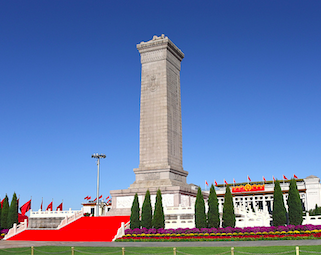
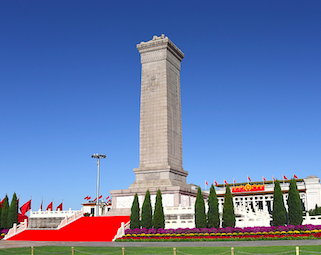 The Monument to the People's Heroes
The Monument to the People's HeroesTian'anmen Square, once serving as the imperial square right outside the main entrance of the Forbidden City, has gradually been constructed into an open and modern square since 1912. It is the largest city center square in the world and a new focal point of Beijing's Central Axis. The Tian'anmen Square building complex consists of the Tian'anmen Square, the Monument to the People's Heroes, the Chairman Mao Memorial Hall, the Great Hall of the People, and the National Museum of China.
As one of China's most important architectural achievements of the second half of the 20th century, the complex has adopted the design principle of the Central Axis, ensuring all buildings are aligned and symmetrical. It is not only the development and extension of the Central Axis but also a sign of respect for its layout and order.
Address: Dongchang'an Avenue, Dongcheng District, Beijing Municipality
Opening hours: 05:00-22:00 all year round
Tickets: Free
(Source: Cloud Central Axis Mini Program)
-

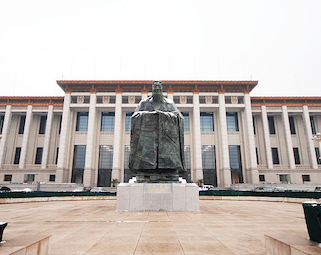 The National Museum of China
The National Museum of ChinaTian'anmen Square, once serving as the imperial square right outside the main entrance of the Forbidden City, has gradually been constructed into an open and modern square since 1912. It is the largest city center square in the world and a new focal point of Beijing's Central Axis. The Tian'anmen Square building complex consists of the Tian'anmen Square, the Monument to the People's Heroes, the Chairman Mao Memorial Hall, the Great Hall of the People, and the National Museum of China.
As one of China's most important architectural achievements of the second half of the 20th century, the complex has adopted the design principle of the Central Axis, ensuring all buildings are aligned and symmetrical. It is not only the development and extension of the Central Axis but also a sign of respect for its layout and order.
Address: Dongchang'an Avenue, Dongcheng District, Beijing Municipality
Opening hours: 05:00-22:00 all year round
Tickets: Free
(Source: Cloud Central Axis Mini Program)
-
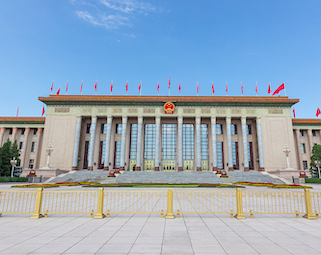
 The Great Hall of the People
The Great Hall of the PeopleTian'anmen Square, once serving as the imperial square right outside the main entrance of the Forbidden City, has gradually been constructed into an open and modern square since 1912. It is the largest city center square in the world and a new focal point of Beijing's Central Axis. The Tian'anmen Square building complex consists of the Tian'anmen Square, the Monument to the People's Heroes, the Chairman Mao Memorial Hall, the Great Hall of the People, and the National Museum of China.
As one of China's most important architectural achievements of the second half of the 20th century, the complex has adopted the design principle of the Central Axis, ensuring all buildings are aligned and symmetrical. It is not only the development and extension of the Central Axis but also a sign of respect for its layout and order.
Address: Dongchang'an Avenue, Dongcheng District, Beijing Municipality
Opening hours: 05:00-22:00 all year round
Tickets: Free
(Source: Cloud Central Axis Mini Program)
-

 The Chairman Mao Memorial Hall
The Chairman Mao Memorial HallTian'anmen Square, once serving as the imperial square right outside the main entrance of the Forbidden City, has gradually been constructed into an open and modern square since 1912. It is the largest city center square in the world and a new focal point of Beijing's Central Axis. The Tian'anmen Square building complex consists of the Tian'anmen Square, the Monument to the People's Heroes, the Chairman Mao Memorial Hall, the Great Hall of the People, and the National Museum of China.
As one of China's most important architectural achievements of the second half of the 20th century, the complex has adopted the design principle of the Central Axis, ensuring all buildings are aligned and symmetrical. It is not only the development and extension of the Central Axis but also a sign of respect for its layout and order.
Address: Dongchang'an Avenue, Dongcheng District, Beijing Municipality
Opening hours: 05:00-22:00 all year round
Tickets: Free
(Source: Cloud Central Axis Mini Program)
-
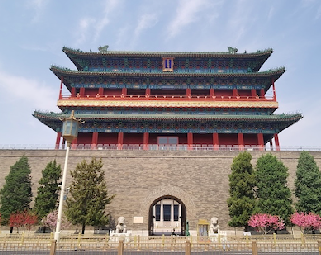
 Zhengyangmen
ZhengyangmenServing as a defensive and ritual building complex, Zhengyangmen is the first gate of the Nine Gates of Beijing and was the south gate of the inner city of both the Ming and Qing dynasties, thus known as the "front door". With its large scale and impressive construction, it is a landmark of the city wall around the old town of Beijing and a memory of the countless ritual activities of the Ming and Qing dynasties. Zhengyangmen was where the guards would make entry inspections, collect taxes, manage transportation, greet and see off honor guards and other duties. It was built in the 17th year of the Yongle period in the Ming Dynasty (1419) and was the most magnificent and the tallest of the nine gates. The Arrow Tower is situated on the south side of Zhengyangmen, with arrow slits towards the east, south, and west. Address: (1) Zhengyangmen: South of Tian’anmen Square. (2) The Arrow Tower: North Point of the Qianmen Street
Official tel.: (8610)65118110
(Source: Cloud Central Axis Mini Program)
-

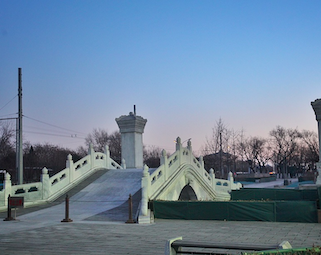 Tianqiao South Street
Tianqiao South StreetTianqiao South Street, gradually formed between Yongdingmen and Tianqiao in Ming Dynasty, has become a gathering place for artists and cultural performers today. Tianqiao South Street starts from the intersection of Tiantan Road and Yong'an Road in the north and ends at Nanwei Road in the south, about 650 meters long. It got its name from its location, at the south of Tianqiao. Like Qianmen Street, it was also a vital route for ritual activities and an important commercial street. From the late 19th century to the early 20th century, it was transformed into a gathering place for artists and cultural performers in the old city of Beijing, and its tradition and cultural function continue to this day.
Address: Tianqiao South Street, Dongcheng District, Beijing Municipality
Opening hours: All day throughout the year
Tickets: Free
(Source: Cloud Central Axis Mini Program)
-
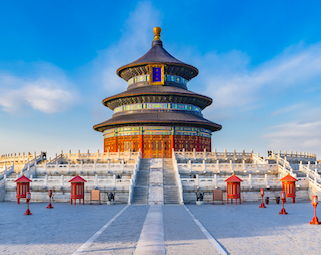
 Temple of Heaven
Temple of HeavenThe Temple of Heaven was the ritual site for the emperors of the Ming and Qing dynasties where they would go to offer sacrifices to the gods of heaven and pray for a good harvest. Covering an area of about 2.73 square kilometers, the Temple of Heaven is the largest existing and best-preserved ancient temple complex for the worship of heaven in China. It is divided into inner and outer temples by the inner wall which is arched in the north and square in the south, reflecting the ancient Chinese view of the universe, i.e. "the sky is round and the earth is square". It was opened as a public park in 1918
Address: No. A1 Tiantan Road, Dongcheng District, Beijing Municipality
Opening hours: 6:00–22:00 (last entry 21:00), April 1–October 31;
6:30–22:00 (last entry 21:00), November 1–March 31.
Tickets: April 1–October 31, CNY 15/per person, half ticket: CNY 7.5/person. Ticket package: CNY 34/person; half ticket: CNY 17/person.
November 1–March 31, CNY 10/person, half ticket: CNY 5/person. Ticket package: CNY 28/person; half ticket: CNY 14 /person.
Official tel.: (8610)67012483
(Source: Cloud Central Axis Mini Program)
-

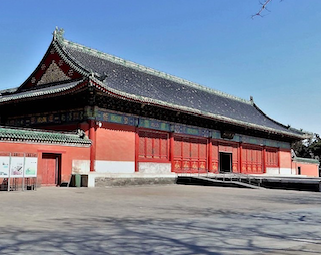 Xiannong Altar
Xiannong AltarXiannong Altar, situated on the west side of the south Central Axis of Beijing, is a national key protected cultural relic. It served as a ritual site where the emperor would perform sacrifices to Xiannong (the gods of agriculture), the gods of Taisui, the god of heaven, and the god of earth, and perform farm work as a part of the ritual activities. The location, layout, and sacrificial rites reflect the tradition that the emperor in the agricultural society would do farm work during the sacrificial activities.
Address: No. 2 Dongjing Road, Xicheng District, Beijing Municipality
Opening hours: 9:00-17:00 (last entry 16:30), closed on Mondays, New Year's Eve, and the first day of the lunar year.
Tickets: CNY 15/person (adult), CNY 8/person (student). Free entrance for the first 200 visitors every Wednesday (subject to entrance order).
Official tel.: (8610)63172150
(Source: Cloud Central Axis Mini Program)
-
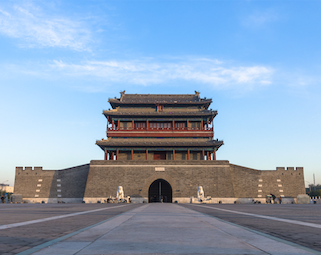
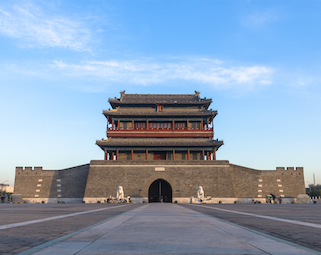 Yongdingmen
YongdingmenYongdingmen, located at the southernmost point of the Central Axis of Beijing, was built in the 32nd year of the Jiajing period of the Ming Dynasty (1553) and it served as the south gate of the outer city of Beijing in the Ming and Qing dynasties. For the development of the modern city, it was demolished in the 1950s. In 2005, it was reconstructed as the landmark of the south point of the Central Axis of Beijing. The newly built Yongdingmen is composed of the main building and the former location of the barbican, serving as the southernmost point of the Central Axis. It has become a site to overlook the old city of Beijing and a public space for the people.
Address: Inside the Yongdingmen Park, Yongdingmen East Binhe Road, Dongcheng District, Beijing Municipality(Source: Cloud Central Axis Mini Program)